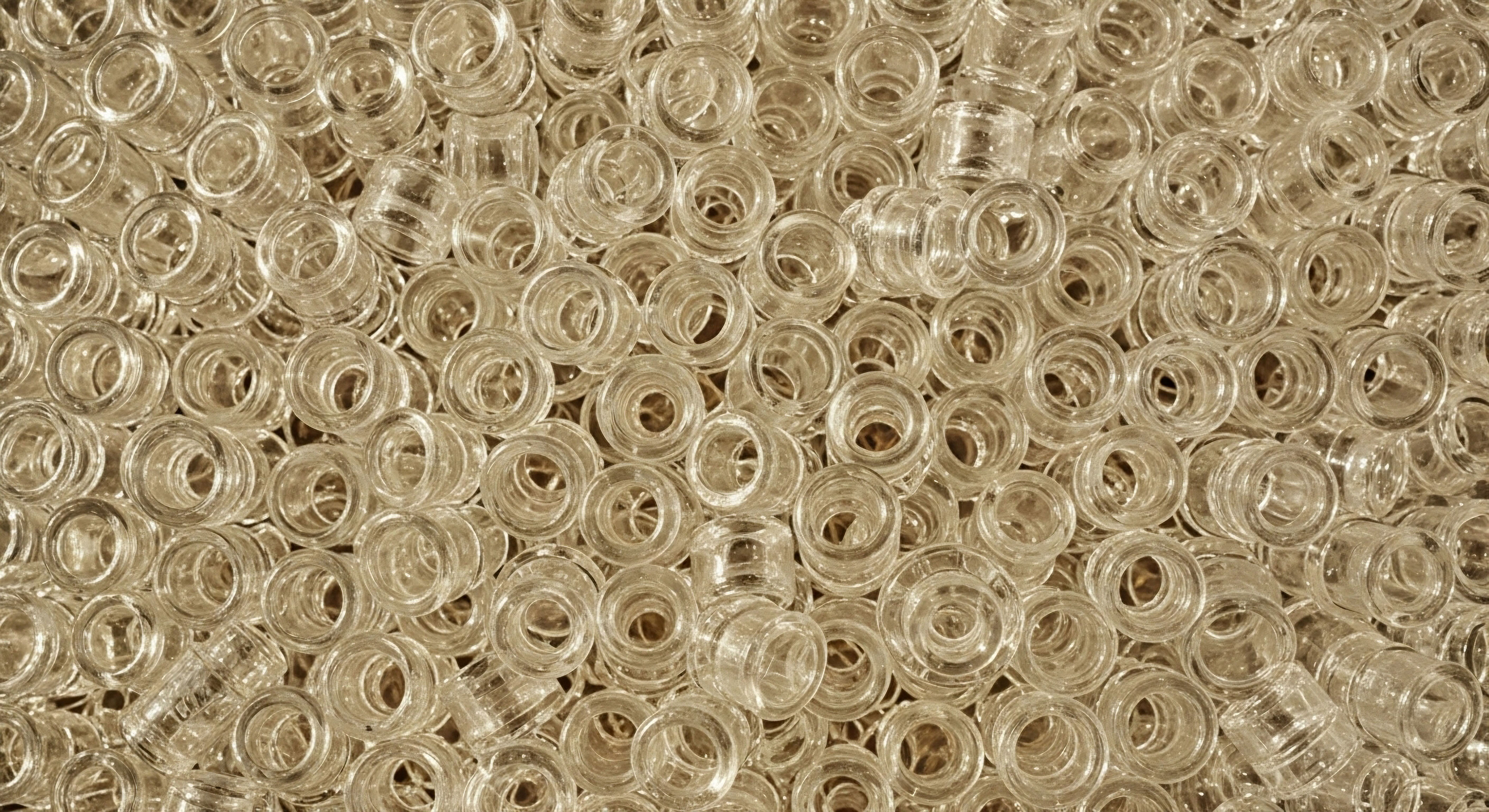

Fundamentals
The question of how to restore hormonal vitality without compromising the fundamental ability to create life is a deeply personal and significant one. You may be experiencing the pervasive symptoms of low testosterone ∞ the fatigue that settles deep in your bones, a quiet fading of ambition and drive, or a loss of physical strength ∞ and feel caught in a clinical paradox.
The conventional path of testosterone replacement therapy offers a solution to the symptoms, yet it often demands a heavy price ∞ the suppression of your body’s own intricate system for producing both testosterone and sperm. This experience, this feeling of being at a crossroads between present vitality and future family-building, is a valid and common concern.
Your body is a coherent, interconnected system, and the desire for a solution that respects its internal logic is the beginning of a more profound health journey.
Understanding how enclomiphene works requires an appreciation for the elegant communication network that governs male physiology, the Hypothalamic-Pituitary-Gonadal (HPG) axis. Think of this as the body’s internal command-and-control center for reproductive and hormonal health. It is a finely tuned feedback loop, a constant conversation between your brain and your testes designed to maintain equilibrium.
The hypothalamus, a small region at the base of the brain, acts as the system’s primary sensor. It monitors levels of hormones in the bloodstream, particularly testosterone and its byproduct, estrogen. When it senses that testosterone levels are optimal, it remains relatively quiet. When it detects a dip, it sends a chemical message, Gonadotropin-Releasing Hormone (GnRH), to its partner, the pituitary gland.
Enclomiphene works by interfacing with the brain’s hormonal control center, prompting it to command the testes to increase both testosterone and sperm production naturally.
The pituitary gland, receiving this GnRH signal, acts as the system’s dispatcher. It releases two critical messenger hormones into the bloodstream ∞ Luteinizing Hormone (LH) and Follicle-Stimulating Hormone (FSH). These two hormones travel through the body with distinct yet complementary missions, both targeting the testes.
LH is a direct signal to the Leydig cells within the testes, instructing them to produce more testosterone. This is the hormone that addresses the symptoms of fatigue, low libido, and diminished well-being. Simultaneously, FSH communicates with a different set of cells, the Sertoli cells, which are the nurseries for sperm production.
FSH gives these cells the command to initiate and maintain spermatogenesis, the complex process of creating mature, healthy sperm. The testosterone produced by the Leydig cells then sends a feedback signal back to the brain, informing the hypothalamus and pituitary that levels are sufficient, thus completing the loop.
Conventional Testosterone Replacement Therapy (TRT) bypasses this entire elegant system. By introducing testosterone from an external source, it floods the bloodstream with the final product. The brain’s sensors in the hypothalamus detect these high levels of testosterone and assume the system is working overtime. In response, it ceases sending GnRH signals.
The pituitary, no longer receiving its instructions, stops dispatching LH and FSH. Consequently, the testes, deprived of their stimulating signals, go dormant. The Leydig cells halt testosterone production, and the Sertoli cells stop maintaining spermatogenesis. This is why TRT, while effective at raising testosterone levels, invariably leads to testicular shrinkage and infertility. It solves one problem by creating another, silencing the body’s innate biological orchestra.
Enclomiphene offers a profoundly different approach. It is classified as a Selective Estrogen Receptor Modulator (SERM). Its primary action occurs at the level of the hypothalamus and pituitary gland. Enclomiphene molecules travel to the brain and selectively block the estrogen receptors.
In men, a small amount of testosterone is naturally converted into estrogen, and the brain uses this estrogen level as a key proxy for overall hormone status. By blocking these receptors, enclomiphene essentially places a blindfold on the brain’s sensors. The hypothalamus, unable to detect estrogen, concludes that testosterone levels must be critically low.
Its response is logical and robust ∞ it begins sending out a strong GnRH signal to the pituitary. The pituitary, in turn, releases a powerful wave of both LH and FSH. These hormones travel to the testes, which are fully capable and waiting for instructions.
The surge in LH revitalizes the Leydig cells to produce more of your body’s own testosterone, while the concurrent surge in FSH ensures the Sertoli cells continue their vital work of spermatogenesis. This mechanism is the key to its unique clinical profile. Enclomiphene does not replace anything; it restores a signal, reminding the body’s own systems how to function optimally. It harmonizes the HPG axis, elevating testosterone levels while simultaneously preserving, and often enhancing, the very processes that ensure fertility.


Intermediate
For the individual already familiar with the basics of the HPG axis, the decision-making process moves toward the specifics of clinical application. Understanding that enclomiphene can stimulate the body’s own hormonal machinery is the first step.
The next involves appreciating the nuances of its chemical nature, its clinical performance relative to other therapies, and the practical realities of its long-term use. This is where we transition from foundational biology to the informed application of clinical science, examining the evidence to understand how this molecule performs in the human body over time.

Enclomiphene versus Its Predecessor Clomiphene
A crucial point of clarification lies in the distinction between enclomiphene and its more widely known parent compound, clomiphene citrate (often prescribed off-label under brand names like Clomid). Clomiphene citrate is what chemists call a racemic mixture, meaning it is composed of two different molecular isomers, or mirror images of each other. These isomers are enclomiphene and zuclomiphene. While they are structurally similar, their effects on the body are quite different.
- Enclomiphene ∞ This is the trans-isomer of clomiphene. It is a potent estrogen receptor antagonist with a relatively short half-life in the body. Its primary action is to block estrogen signaling at the pituitary, which drives the desired increase in LH and FSH, leading to greater testosterone and sperm production.
- Zuclomiphene ∞ This is the cis-isomer. It is a weak estrogen receptor agonist, meaning it mildly activates estrogen receptors. Crucially, it has a much longer half-life than enclomiphene, causing it to accumulate in the body over time. This lingering, weakly estrogenic effect can sometimes be associated with side effects like mood swings or other unwanted estrogenic symptoms in men.
The development of enclomiphene as a purified, single-isomer medication was driven by the goal of isolating the beneficial antagonistic effects while eliminating the potentially problematic agonistic effects of zuclomiphene. By using only the enclomiphene isomer, the therapy aims to deliver a cleaner, more targeted signal to the HPG axis, maximizing the stimulation of testosterone and sperm production with a potentially lower risk of side effects associated with its counterpart.

A Direct Comparison of Therapeutic Protocols
When considering hormonal optimization, men are often presented with a choice between stimulating their own production with a SERM or replacing their supply with TRT. A direct comparison of the protocols reveals their fundamentally different physiological impacts. The following table outlines these differences based on available clinical data.
| Feature | Enclomiphene Therapy | Testosterone Replacement Therapy (TRT) |
|---|---|---|
| Primary Mechanism | Works upstream at the pituitary gland to increase the body’s natural production of LH and FSH, stimulating the testes. | Works downstream by directly supplying the body with exogenous testosterone, bypassing the natural signaling cascade. |
| Effect on Spermatogenesis | Maintains or enhances sperm production by increasing FSH levels, which directly support Sertoli cell function. | Suppresses and often halts sperm production by shutting down the brain’s release of FSH and LH. |
| Impact on Testicular Volume | Testicular size is maintained or may increase due to continued stimulation from LH and FSH. | Testicular volume typically decreases (atrophy) as the testes become dormant from lack of stimulation. |
| Endogenous Testosterone | The body’s own production is actively stimulated and increased. | The body’s own production is suppressed and replaced by the external source. |
| Administration Route | Oral tablet, typically taken daily. | Intramuscular injections, subcutaneous injections, transdermal gels, or surgically implanted pellets. |
| Post-Treatment State | Hormone levels typically return to the individual’s baseline within a week or two after cessation. A “legacy effect” may persist for a short period. | A period of significant hormonal crash is common after cessation as the natural system has been suppressed and must be actively restarted. |

What Is the Evidence for Long Term Efficacy and Safety?
The central question remains ∞ can this stimulation of spermatogenesis be maintained safely over extended periods? While large-scale, multi-decade studies on purified enclomiphene are limited, the existing research on both enclomiphene and the more established clomiphene citrate provides a strong, reassuring signal.
A pivotal study published in Fertility and Sterility directly compared enclomiphene to a topical testosterone gel in men with secondary hypogonadism. The results were striking. While both treatments successfully raised testosterone levels into the normal range, their effects on fertility were polar opposites. After 16 weeks, the men using testosterone gel saw their average sperm counts decrease by 60%. In contrast, the men taking enclomiphene experienced no change from their baseline sperm count, demonstrating a clear preservation of spermatogenesis.
Clinical trials show that while both TRT and enclomiphene can normalize testosterone, only enclomiphene does so while preserving the body’s natural sperm production pathways.
For longer-term data, we can look to studies on clomiphene citrate, which has a much longer history of use. A 2019 study published in the Journal of Urology examined the effects of long-term clomiphene use in 400 men with hypogonadism. The findings were highly encouraging.
Among the men treated for over three years, 88% achieved normal testosterone levels, and 77% reported a significant improvement in their symptoms. Importantly, side effects were minimal, and the treatment was well-tolerated over this extended period, suggesting a durable and safe profile for stimulating the HPG axis. While this study used the combined isomers of clomiphene, its findings support the principle that long-term SERM therapy is a viable strategy for maintaining testosterone production without the fertility trade-offs of TRT.
The protocol for long-term enclomiphene use involves continuous daily administration. This is not a therapy that is cycled on and off, because its effects are dependent on its presence in the system. When the medication is stopped, the blocking effect on the brain’s estrogen receptors ceases, and the HPG axis returns to its original baseline state.
Therefore, maintaining the elevated levels of testosterone and the robust support for spermatogenesis requires consistent, long-term treatment. This is managed under clinical supervision, with periodic blood work to ensure that testosterone, LH, FSH, and estradiol levels remain within optimal ranges, allowing for dosage adjustments as needed to personalize the therapy to the individual’s unique physiology.


Academic
An academic exploration of enclomiphene’s long-term impact on spermatogenesis moves beyond clinical efficacy and into the realm of systems biology and cellular endocrinology. The core question evolves from “Does it work?” to “What are the deep, sustained physiological consequences of chronically modulating the Hypothalamic-Pituitary-Gonadal axis?” This requires a granular analysis of its pharmacodynamics, the potential for cellular adaptation within the testes, and the broader systemic effects that might manifest over years or decades of continuous therapy. It is a dialogue about homeostasis, cellular resilience, and the intricate regulatory networks that govern male reproductive physiology.

Pharmacodynamics at the Estrogen Receptor Alpha
Enclomiphene’s mechanism is predicated on its function as a competitive antagonist at the estrogen receptor alpha (ERα), the predominant estrogen receptor subtype within the hypothalamus and pituitary gland. By binding to these receptors without activating them, it prevents the endogenous circulating estradiol from exerting its natural negative feedback.
This molecular action is the initiating signal for increased GnRH pulsatility from the hypothalamus, which in turn drives the synthesis and release of LH and FSH from the pituitary gonadotroph cells. The sustained elevation of these gonadotropins is the primary driver of both increased steroidogenesis in Leydig cells and stimulated spermatogenesis in the Sertoli cells of the seminiferous tubules.
The long-term sustainability of this effect hinges on the concept of receptor sensitivity. A key theoretical question in endocrinology is whether chronic stimulation can lead to receptor downregulation or desensitization in the target tissue. In the case of the testes, are the LH and FSH receptors on Leydig and Sertoli cells susceptible to diminished responsiveness after years of elevated gonadotropin levels?
The existing clinical data with clomiphene citrate, showing sustained efficacy for periods exceeding three years, suggests that clinically significant desensitization is not a common outcome. This may be because enclomiphene therapy, while elevating gonadotropins, still allows for some degree of diurnal and physiological fluctuation, a state that is different from the continuous, unvarying stimulation seen in some pathological conditions.
The HPG axis retains its capacity to respond, suggesting the cellular machinery of the testes is robust enough to handle a higher operational set-point for extended durations.

Cellular Resilience and Testicular Function under Chronic Stimulation
The process of spermatogenesis is one of the most complex and metabolically demanding processes in the human body. It is critically dependent on two pillars of support within the testes ∞ the testosterone produced by Leydig cells and the direct nurturing environment provided by Sertoli cells, which is orchestrated by FSH. Long-term enclomiphene therapy effectively places these cells under a state of sustained high performance.
- Leydig Cell Function ∞ Under the constant influence of elevated LH, Leydig cells are tasked with maintaining a higher rate of testosterone synthesis. This involves upregulating the entire steroidogenic pathway, from the transport of cholesterol into the mitochondria via the StAR protein to the enzymatic conversions that follow. The long-term question is one of cellular health and precursor availability. Do these cells maintain their efficiency, or do they eventually show signs of metabolic stress? The evidence to date points toward sustained function, likely because the stimulation, while elevated, remains within a physiologic, albeit high-normal, range.
- Sertoli Cell Function ∞ FSH is the master regulator of Sertoli cell function, which in turn governs sperm production. Sertoli cells create the blood-testis barrier, provide nutrients to developing sperm cells, and phagocytose apoptotic germ cells. Sustained FSH stimulation from enclomiphene therapy ensures these vital functions are maintained. Unlike TRT, which silences FSH and starves the Sertoli cells of their primary signal, enclomiphene provides a continuous command to support the spermatogenic process. This is the fundamental reason it preserves fertility. The maintenance of this process over years indicates that the Sertoli cells do not become refractory to the FSH signal under therapeutic conditions.

What Are the Regulatory Hurdles and the Research Frontier?
Despite a compelling body of evidence for its efficacy and safety profile, purified enclomiphene citrate has faced a challenging regulatory path and is not formally FDA-approved for treating secondary hypogonadism. This situation arises from a confluence of factors, including the commercial viability of pursuing a new drug application when a similar, much cheaper generic alternative (clomiphene citrate) is already widely used off-label.
The FDA has also raised questions that would require further extensive and expensive trials to answer definitively, creating a barrier to its formal entry into the market as a standalone therapy. This leaves enclomiphene in a position of being available primarily through compounding pharmacies, prescribed by clinicians who understand its specific benefits over the racemic mixture of clomiphene.
The long-term viability of enclomiphene therapy relies on the testicular cells’ ability to adapt to a higher, yet still physiologic, level of hormonal stimulation without desensitization.
The research frontier requires head-to-head, long-term comparative trials. The following table outlines the key parameters of notable studies, highlighting the need for more direct comparisons.
| Study / Trial ID | Drug(s) Studied | Duration | Key Findings on Spermatogenesis | Limitations Noted |
|---|---|---|---|---|
| Wiehle et al. (2014) | Enclomiphene vs. Topical Testosterone | 16 weeks | Enclomiphene maintained sperm concentrations at baseline levels. Testosterone gel caused significant decreases. | Relatively short duration; did not assess long-term sustainability. |
| ZA-203 Study | Enclomiphene Citrate | ~6 months | Showed preservation of normal sperm counts while restoring testosterone levels to the eugonadal range. | Phase II trial; requires larger, longer Phase III validation. |
| Katz et al. (2019) | Clomiphene Citrate | >3 years | Demonstrated sustained testosterone production and symptom improvement with good safety profile. Spermatogenesis was not the primary endpoint but no major fertility issues were reported. | Retrospective study; used clomiphene (not pure enclomiphene); lacked a control group. |
| Future Ideal Trial | Enclomiphene vs. Clomiphene vs. Placebo | 5+ years | Would need to directly compare sperm parameters (count, motility, morphology), bone mineral density, and cardiovascular markers. | Such a trial would be expensive and complex, representing a significant barrier. |
The ultimate academic view is that enclomiphene represents a highly logical and targeted application of endocrine principles. It leverages the body’s own regulatory architecture to achieve a desired outcome. While the current body of evidence strongly supports its ability to maintain spermatogenesis over extended treatment periods of several years, the scientific community awaits more robust, prospective, multi-year data to fully characterize its impact on the entire physiological system over a significant fraction of a human lifespan.
The existing data provides a strong foundation for its use in men for whom the preservation of the spermatogenic process is a primary therapeutic goal.

References
- Wiehle, R. D. Fontenot, G. K. Wike, J. et al. “Enclomiphene citrate stimulates testosterone production while preventing oligospermia ∞ a randomized phase II clinical trial comparing topical testosterone.” Fertility and Sterility, vol. 102, no. 3, 2014, pp. 720-727.
- Katz, D. J. et al. “Outcomes of Long-Term Clomiphene Citrate Treatment in Men with Hypogonadism.” BJU International, vol. 110, 2019, as referenced in secondary sources.
- McCullough, Andrew R. “Enclomiphene Increases Testosterone and Preserves Spermatogenesis ∞ Results of Two Phase 3 Trials.” Presented at the Annual Meeting of the American Urological Association, 2015.
- Earl, M. & Khera, M. “Enclomiphene Citrate for the Treatment of Secondary Male Hypogonadism.” Expert Review of Endocrinology & Metabolism, vol. 10, no. 5, 2015, pp. 1-7.
- Helms, E. R. Khera, M. & Lipshultz, L. I. “The role of selective estrogen receptor modulators in male hypogonadism and infertility.” Current Opinion in Urology, vol. 30, no. 3, 2020, pp. 339-345.
- “Final Summary Minutes of the Pharmacy Compounding Advisory Committee Meeting.” Food and Drug Administration (FDA), 8 June 2022.
- Wexler, T. L. “Enclomiphene citrate improves hormone levels while preserving sperm production in men with secondary hypogonadism.” Medscape, 2016.

Reflection
The information presented here offers a map of the biological pathways and clinical strategies available for hormonal optimization. It translates the complex language of endocrinology into a framework for understanding your own body. This knowledge is the foundational tool for transforming your health journey from one of passive concern to one of proactive, informed decision-making.
The data and mechanisms provide the ‘what’ and the ‘how,’ but the ‘why’ remains uniquely yours. Consider the symptoms you experience not as isolated problems, but as signals from a complex, intelligent system. What is your body communicating? What are your personal goals for vitality, for family, for longevity?
The path forward involves taking this objective scientific understanding and integrating it into a conversation ∞ first with yourself, and then with a clinical guide who can help apply these principles to your specific physiology. Your biology is your own, and the power to direct its course begins with this deeper level of insight.



